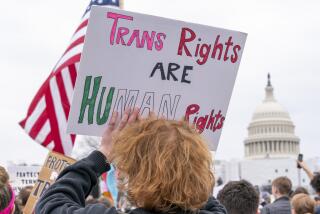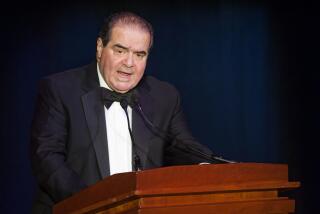Supreme Court Will Decide if It Is Legal to Ban Hate Acts Based on Race, Religion : Judiciary: Laws against offenses such as cross burnings may be in jeopardy because of flag desecration ruling.
- Share via
WASHINGTON — The Supreme Court, which has thrown out laws against flag burning, entered the national debate over hate crimes Monday by agreeing to decide whether government may punish people who engage in cross burnings or other expressions of racial or religious hatred.
The high court review could help define where free speech ends and intolerable “hate speech” begins.
At least 32 states and hundreds of cities have enacted laws in recent years that make it a crime to burn a cross, display a Nazi swastika or use symbols meant to intimidate blacks or Jews. At the same time, hundreds of colleges have sought to prevent hate speech on campus by enacting discipline codes under which students may be punished for writing racist graffiti or burning a cross.
These hate crime laws could be in jeopardy because of a Supreme Court ruling two years ago that was widely applauded by liberals and civil libertarians.
The high court said in Texas vs. Johnson that the symbolic burning of an American flag may not be punished as a crime. Flag burning, although offensive to many, is a form of free expression that is protected by the First Amendment, the justices said in the 5-4 ruling.
“If there is a bedrock principle underlying the First Amendment, it is that the government may not prohibit the expression of an idea simply because society finds the idea itself offensive or disagreeable,” Justice William J. Brennan Jr. wrote for the court in that decision.
Now, the justices will decide if this principle invalidates local and state ordinances that are designed to punish the Ku Klux Klan and other racists who burn crosses as a symbolic means of intimidating blacks.
The justices said Monday that they will hear an appeal filed by a 17-year-old from Minnesota who, along with four other people, burned a cross in the front yard of a black family on the night of June 21, 1990.
The teen-ager, identified only as R.A.V., was charged under a 1989 St. Paul, Minn., city ordinance that makes it a misdemeanor to place “on public or private property a symbol . . . (such as) . . . a burning cross or Nazi swastika, which one knows or has reasonable grounds to know arouses anger, alarm or resentment in others on the basis of race, color, creed, religion or gender . . . .”
A juvenile court judge dismissed the charge and declared the ordinance unconstitutional on the basis of the high court’s flag-burning ruling. But the Minnesota Supreme Court heard the city’s appeal and upheld the law.
“Burning a cross in the yard of an African-American family’s home is deplorable conduct . . . (and) is itself an unmistakable symbol of violence and hatred based on virulent notions of racial supremacy,” the state Supreme Court said. “It is the responsibility, even the obligation, of diverse communities to confront such notions in whatever form they appear.”
The state high court said that the St. Paul ordinance is different from the Texas anti-flag-burning law because it punishes only those cross burnings directed at other individuals because of their race.
The case (R.A.V. vs. St. Paul, 90-7675) will be heard by the Supreme Court in the fall, with a ruling expected next year. A key vote in the case will be cast by new Justice David H. Souter, who replaced Brennan last year. The cross-burning case already has split usual liberal allies.
The American Civil Liberties Union chapter in Minnesota opposed the St. Paul ordinance on free speech grounds, but the NAACP and the Anti-Defamation League of B’nai B’rith defended it.
Mark Anfinson, an ACLU attorney in Minneapolis, said that the St. Paul teen-ager could be punished for trespassing, vandalism or destruction of property but not for “expressive behavior” that offends another person.
But Stephen Freeman, legal affairs director of the Anti-Defamation League in New York, said that the St. Paul ordinance was properly used in this case.
“This was the quintessential hate crime,” Freeman said. “It was intended to intimidate this family or drive them out of the community. That is far different from burning a flag on public property to convey a political message.”
Under California law, it is a crime, punishable by up to one year in jail or a $5,000 fine, if “any person . . . burns or desecrates a cross or other religious symbol . . . or places a sign, mark, symbol, emblem, or other physical impression, including but not limited to a Nazi swastika, on the private property of another . . . for the purpose of terrorizing . . . .”
The California law has been upheld as constitutional in the state courts, a spokesman for California Atty. Gen. Dan Lungren said.
The debate over free speech versus hate speech has divided many college campuses in the last two years. An estimated 200 colleges and universities have enacted discipline codes in an effort to put a stop to racial slurs and sexist comments on campus.
Defenders of the new codes say that minority students deserve the protection of a civil environment and add that racist expressions have no value as free speech. Critics have questioned the wisdom of choosing certain words or phrases to be outside the sphere of free speech and have argued that true free speech must include the vile and ugly as well as the polite and thoughtful.
In another action Monday, the high court refused to reinstate an $875,000 libel award won by a research scientist who said that his reputation had been harmed by the publication of a letter from his employer that reprimanded him (Reuber vs. Food Chemical News, 90-1615). In 1981, Melvin Reuber contended that malathion, the pesticide used against the Mediterranean fruit fly in California, could cause cancer. His conclusion contradicted the view of the National Cancer Institute.
Reuber’s employer reprimanded him for publicizing his controversial conclusion, and a newsletter owned by Food Chemical News published the reprimand. A jury ruled that Reuber had been libeled, but a federal appeals court threw out the verdict. It concluded that Reuber was a public figure who failed to prove that the newsletter’s report was false or malicious.
More to Read
Sign up for Essential California
The most important California stories and recommendations in your inbox every morning.
You may occasionally receive promotional content from the Los Angeles Times.











